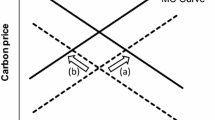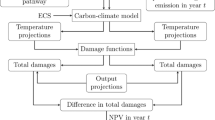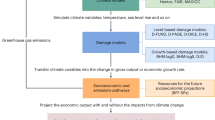Abstract
Marginal abatement cost (MAC) curves, relationships between tonnes of emissions abated and the CO2 (or greenhouse gas (GHG)) price, have been widely used as pedagogic devices to illustrate simple economic concepts such as the benefits of emissions trading. They have also been used to produce reduced-form models to examine situations where solving the more complex model underlying the MAC is difficult. Some important issues arise in such applications: (1) Are MAC relationships independent of what happens in other regions?, (2) are MACs stable through time regardless of what policies have been implemented in the past?, and (3) can one approximate welfare costs from MACs? This paper explores the basic characteristics of MAC and marginal welfare cost (MWC) curves, deriving them using the MIT Emissions Prediction and Policy Analysis model. We find that, depending on the method used to construct them, MACs are affected by policies abroad. They are also dependent on policies in place in the past and depend on whether they are CO2-only or include all GHGs. Further, we find that MACs are, in general, not closely related to MWCs and therefore should not be used to derive estimates of welfare change. We also show that, as commonly constructed, MACs may be unreliable in replicating results of the parent model when used to simulate GHG policies. This is especially true if the policy simulations differ from the conditions under which the MACs were simulated.






Similar content being viewed by others
Notes
The EPPA model can also be solved as a forward looking model [4]. Solved in that manner, the behavior is very similar in terms of abatement and CO2-e prices compared to a recursive solution with the same model features. However, the solution requires elimination of some of the technological alternatives.
The right set of MACs for a country is somewhat less clear when international emissions trading is allowed. See Morris et al. [5] for further discussion.
For additional comparison with the Ellerman and Decaux analysis, see Morris et al. [5].
For additional examples demonstrating this result, see Morris et al. [5].
For discussion of terms of trade effects in specific policy settings in the US, see Paltsev et al. [10].
For a detailed critique of the McKinsey approach, see Kesicki and Ekins [12].
References
Paltsev, S., Reilly, J., Jacoby, H., Eckaus, R., McFarland, J., Sarofim, M., Asadoorian, M., Babiker, M. (2005). The MIT Emissions Prediction and Policy Analysis (EPPA) model: Version 4. MIT Joint Program on the Science and Policy of Global Change Report 125, August. http://web.mit.edu/globalchange/www/MITJPSPGC_Rpt125.pdf. Accessed 12 Oct 2011
Ellerman, A. D., & Decaux, A. (1998) Analysis of post-Kyoto CO2 emissions trading using marginal abatement curves. MIT Joint Program on the Science and Policy of Global Change Report 40, October. http://web.mit.edu/globalchange/www/MITJPSPGC_Rpt40.pdf. Accessed 12 Oct 2011.
Klepper, G., & Peterson, S. (2006). Marginal abatement cost curves in general equilibrium: The influence of world energy prices. Resource and Energy Economics, 28(1), 1–23.
Gurgel, A., Paltsev, S., Reilly, J., Metcalf, G. (2007) U.S. greenhouse gas cap-and-trade proposals: Application of a forward-looking computable general equilibrium model. MIT Joint Program on the Science and Policy of Global Change Report 150, June. http://globalchange.mit.edu/files/document/MITJPSPGC_Rpt150.pdf. Accessed 12 Oct 2011.
Morris, J., Paltsev, S., Reilly, J. (2008). Marginal abatement costs and marginal welfare costs for greenhouse gas emissions reductions: Results from the EPPA model. MIT Joint Program on the Science and Policy of Global Change Report 164, November. http://globalchange.mit.edu/files/document/MITJPSPGC_Rpt164.pdf. Accessed 12 Oct 2011.
Goulder, L. (1995). Environmental taxation and the ‘double dividend’: A reader’s guide. International Tax and Public Finance, 2, 157–183.
Metcalf, G., Babiker, M., Reilly, J. (2004). A note on weak double dividends. Topics in Economic Analysis & Policy, 4(1), Article 2.
Paltsev, S., Reilly, J., Jacoby, H., & Tay, K. (2007). How (and why) do climate policy costs differ among countries? In M. Schlesinger, H. Kheshgi, J. Smith, F. C. de la Chesnaye, J. Reilly, T. Wilson, & C. Kolstad (Eds.), Human-induced climate change: An interdisciplinary assessment. Cambridge: Cambridge University Press.
Webster, M., Paltsev, S., & Reilly, J. (2010). The hedge value of international emissions trading under uncertainty. Energy Policy, 38(4), 1787–1796.
Paltsev, S., Reilly, J., Jacoby, H., Gurgel, A., Metcalf, G., Sokolov, A., & Holak, J. (2008). Assessment of U.S. GHG cap-and-trade proposals. Climate Policy, 8(4), 395–420.
Creyts, J., Derkach, A., Nyquist, S., Ostrowski, K., Stephenson, J. (2007). Reducing U.S. greenhouse gas emissions: How much at what cost? U.S. Greenhouse Gas Abatement Mapping Initiative, Executive Report, December. New York: McKinsey & Company.
Kesicki, F., & Ekinsm P. (2011). Marginal abatement cost curves: A call for caution. Climate Policy, in press.
Acknowledgments
We thank Denny Ellerman for his valuable comments. We are also thankful to Jaemin Song for research assistance on an earlier version of this paper. The EPPA model used in the analysis is supported by a consortium of government, industry, and foundation sponsors of the MIT Joint Program on the Science and Policy of Global Change (http://globalchange.mit.edu).
Author information
Authors and Affiliations
Corresponding author
Electronic Supplementary Material
Below is the link to the electronic supplementary material.
ESM 1
(XLS 437 kb)
Rights and permissions
About this article
Cite this article
Morris, J., Paltsev, S. & Reilly, J. Marginal Abatement Costs and Marginal Welfare Costs for Greenhouse Gas Emissions Reductions: Results from the EPPA Model. Environ Model Assess 17, 325–336 (2012). https://doi.org/10.1007/s10666-011-9298-7
Received:
Accepted:
Published:
Issue Date:
DOI: https://doi.org/10.1007/s10666-011-9298-7




